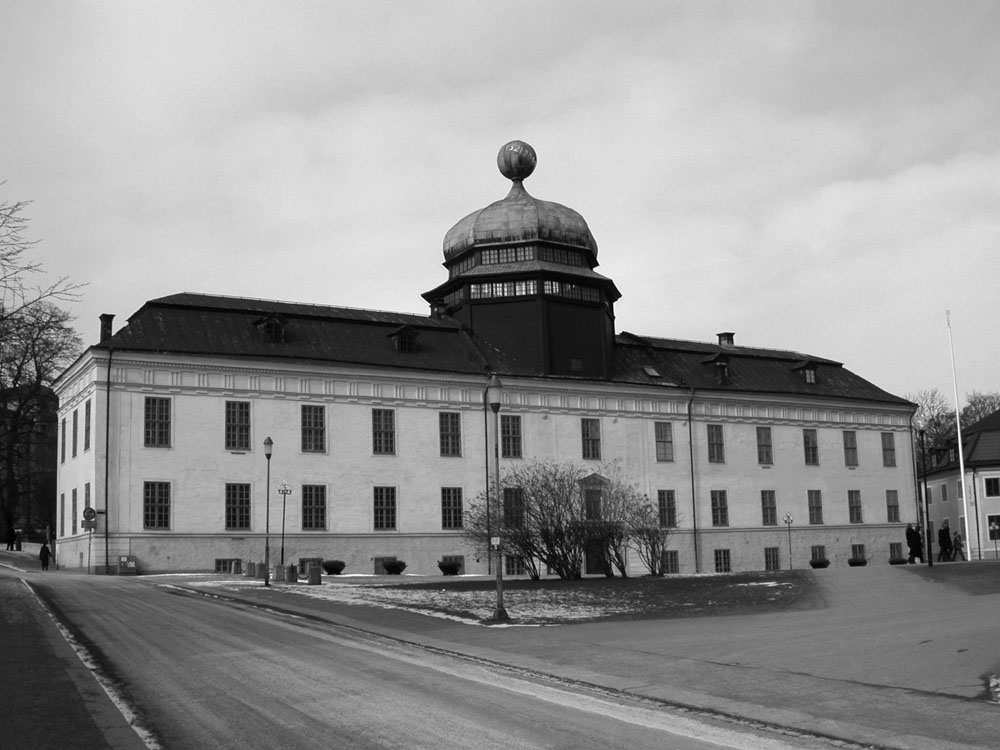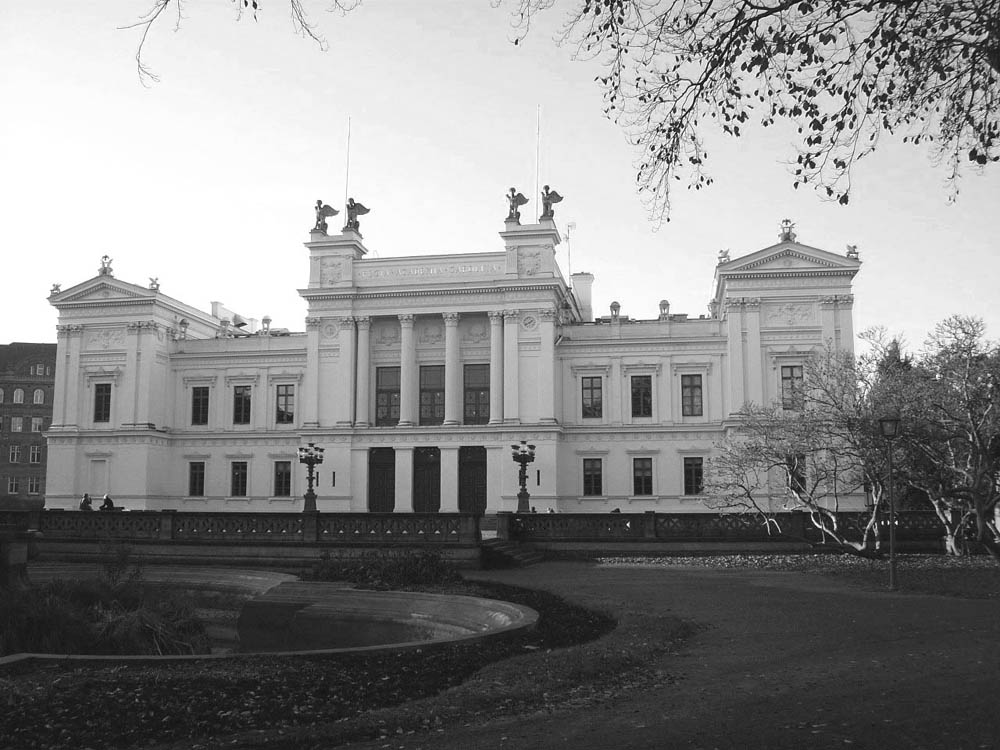Uppsala and Lund Universities
There are 14 state universities and 22 state university colleges in Sweden. In addition, there are 3 independent higher education institutions that are entitled to offer postgraduate programs: Chalmers University of Technology, the Stockholm School of Economics and Jönköping University Foundation. There are also 9 independent program providers that are entitled to offer undergraduate programs and a number of course providers entitled to award qualifications in psychotherapy. The oldest and arguably most prestigious universities remain in Uppsala and Lund.
-
 Gustavianum, the former main building of Uppsala University, built 1622-1625 and named after King Gustavus Adolphus. Under the cupola is the theatrum anatomicum, added to the building in the mid-17th century by Olaus Rudbeck, professor of medicine and amateur architect.
Gustavianum, the former main building of Uppsala University, built 1622-1625 and named after King Gustavus Adolphus. Under the cupola is the theatrum anatomicum, added to the building in the mid-17th century by Olaus Rudbeck, professor of medicine and amateur architect. -
-
Uppsala University
Motto:”Gratiae veritas naturae” (“Truth through God’s mercy and nature”)
Established: 1477
Location: Uppsala
Students: 30,450
Doctoral students: 2,400
Website: www.uu.se -
 The main building of Lund University was designed by architect Helgo Zettervall and inaugurated by King Oscar II in 1882. There were originally four sphinxes on the roof that had to be removed after some 30 years because of bad quality. In the 1990s four new sphinxes were added to the roof.
The main building of Lund University was designed by architect Helgo Zettervall and inaugurated by King Oscar II in 1882. There were originally four sphinxes on the roof that had to be removed after some 30 years because of bad quality. In the 1990s four new sphinxes were added to the roof. -
-
Uppsala University (Uppsala universitet) is a world-class research university in Uppsala, Sweden. Founded as early as 1477, it is the oldest such institution of the Nordic countries and is frequently ranked among the world’s top 100 universities. One of the main centers of higher education in Europe, the university rose to pronounced significance during Sweden's rise as a great power at the end of the 16th century. Uppsala University was given a relative financial stability with a large donation by King Gustavus Adolphus in the early 17th century. In addition, Uppsala also has an important place in Swedish national culture and identity: in historiography, literature and music. Many aspects of Swedish academic culture in general, such as the white student cap, originated in Uppsala.
It shares some peculiarities, such as the student nation system, with Lund University (founded in 1666) and the University of Helsinki. The university has nine faculties distributed over three so-called disciplinary domains. It has about 30,000 students, and about 2,400 doctoral students. It has a teaching staff of 3,800 out of a total of 6,000 employees. Of its annual turnover of around 4.3 billion SEK (approx. 715 million USD), approximately 60% goes to graduate studies and research. It belongs to the Coimbra Group of European universities.
Architecturally, Uppsala University has traditionally had a strong presence in the area around the cathedral on the western side of the Fyrisån. Despite some more contemporary building developments further from the center, Uppsala's historic center continues to be dominated by the presence of the university. As with most medieval universities, Uppsala University initially grew out of an ecclesiastical center. The archbishopric of Uppsala had been one of the most important sees in Sweden proper since Christianity first spread to this region in the ninth century. Uppsala had also long been a hub for regional trade, and had contained settlements dating deep into the Middle Ages. As was also the case with most medieval universities, Uppsala had initially been chartered through a papal bull. Uppsala’s bull, which granted the university its corporate rights, was issued by Pope Sixtus IV in 1477, and established a number of provisions. Among the most important of these was that the university was officially given the same freedoms and privileges as the University of Bologna. This included the right to establish the four traditional faculties of theology, law (Canon Law and Roman law), medicine, and philosophy, and to award the bachelors, masters, licentiate, and doctorate degrees. The archbishop of Uppsala was also named as the university’s Chancellor, and was charged with maintaining the rights and privileges of the university and its members. -
Women at Uppsala University
The first female student in Sweden was Betty Pettersson (1838–1885), who had already worked as a private tutor for several years when she took the "studentexamen" in 1871. With a royal dispensation, she was allowed to enter university in Uppsala in 1872, the year before studies at the Philosophical faculty would actually be made available to women. She studied modern European languages and was the first woman in Sweden to complete an academic degree when she finished filosofian kandidaatti in 1875. She became the first woman to be employed as a teacher in a public school for boys. The first woman in Sweden to complete a doctoral degree was Ellen Fries (1855–1900), who entered Uppsala University in 1877 and became a Ph.D. in 1883. Another female student of this period is Lydia Wahlström (1869–1954), who later became a noted educator, activist and writer on women's emancipation and suffrage. -
Famous alumni:
Carl Jonas Love Almqvist
August Strindberg
Hjamar Branting
Gustaf Fröding
Pär Lagerkvist
Dag Hammarskjöld
Tage Danielsson
Anna Lindh -
Lund University
Motto: “Ad utrumque” (“Prepared for both”)
Established: 1666
Location: Lund
Students: 42,500
Doctoral students: 3,200
Website: www.lu.se -
Lund University (Lunds universitet) is one of Sweden’s most prestigious universities as well as one of Scandinavia’s largest institutions for education and research, frequently ranked among the world’s top 100 universities. It was founded in 1666 and is the second oldest within Sweden’s present borders, but can trace its roots back to 1438, when a studium generale (an institution of higher learning established during the Gothic period) was founded in Lund in 1425. It had to close in 1536 in connection with the Danish reformation.
Lund has 7 faculties with additional campuses in Malmö and Helsingborg, with a total of 42,500 students enrolled in more than 50 different programs and 800 separate courses. It belongs to the League of European Research Universities as well as the global Universitas 21 network. The university centers on the Lundagård Park, next to the Lund Cathedral. It has various departments spread in different locations in town, but most are concentrated in a belt stretching north from the park to the university hospital area and continuing to the northeastern periphery of the town. There one finds the large campus of the Lund Institute of Technology. The university was named Academia Carolina after Charles X Gustav of Sweden. The name was in some formal use until the late 19th century when Lund University became the widespread title. At its founding the university was granted four faculties: law, theology, medicine and philosophy. They were the corner stones, and for more than 200 years this system was in effect. Some notable professors in the early days were Samuel Pufendorf, a juridical historian, and Canutus Hahn and Kristian Papke in philosophy.
The number of students fell below 200 near 1760 and the university reputation dropped. However, by 1780 its reputation was largely restored and continued to rise through the 1820s. This was largely owing to popular and well-educated lecturers particularly in philology; the prominent professor Esaias Tegnér was a particularly notable character with widespread authority. He, in turn, attracted others towards Lund. One of these was the young theological student C. G. Brunius, who studied ancient languages under Tegnér and later became professor of Greek. With time he devoted himself to architecture and redesigned several of Lund's buildings as well as churches of the province. -
Women at Lund University
The first woman to study in Lund was the medical student Hedda Andersson who entered the university in 1880 (two years before the next woman to do so). Hilma Borelius was the first woman to finish a doctorate in Lund, in 1910. The first woman to be appointed to a professor's chair was the historian Birgitta Odén (1965). In 1992 Boel Flodgren, Professor of Business Law, was appointed rector magnificus (or, strictly speaking, rectrix magnifica) of Lund University. As such, she was the first woman to be a head of a European university. -
Academics
Lund University is internationally known as Scandinavia's largest research university. The university has eight faculties and many research centers and specialized institutes. Approximately 42,500 students study within one of the 100 educational programs, the eighteen international masters programs or the 1,400 courses. Almost three hundred courses are, or can be, held in English for the benefit of international exchange students. There are several programs allowing foreign students to study abroad at the University. Notable exchangees include United States Supreme Court Justice Ruth Bader Ginsburg, who conducted research at Lund University in the 1960s. -
Famous alumni:
Esaias Tegnér
Hasse Alfredson
Tage Erlander
Leif Silbersky
Pehr G. Gyllenhammar
Ingvar Carlsson
Jonas Hafström -
-
-
